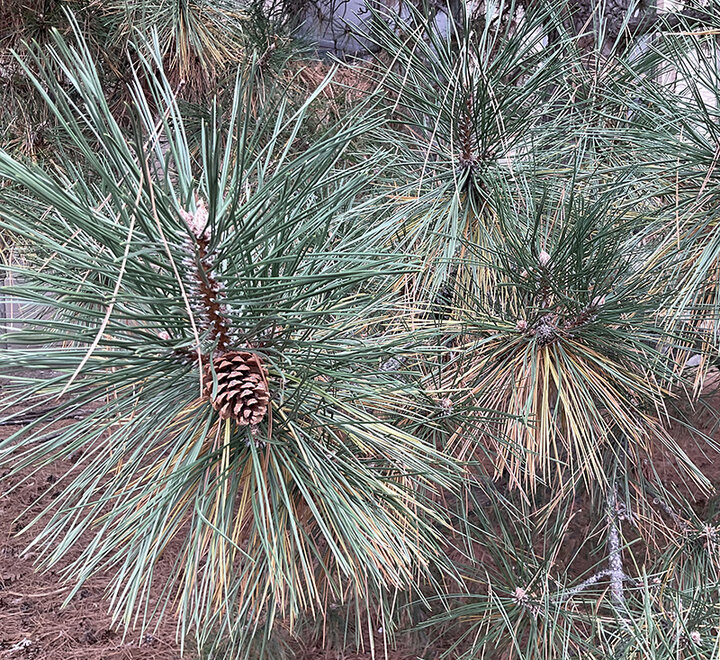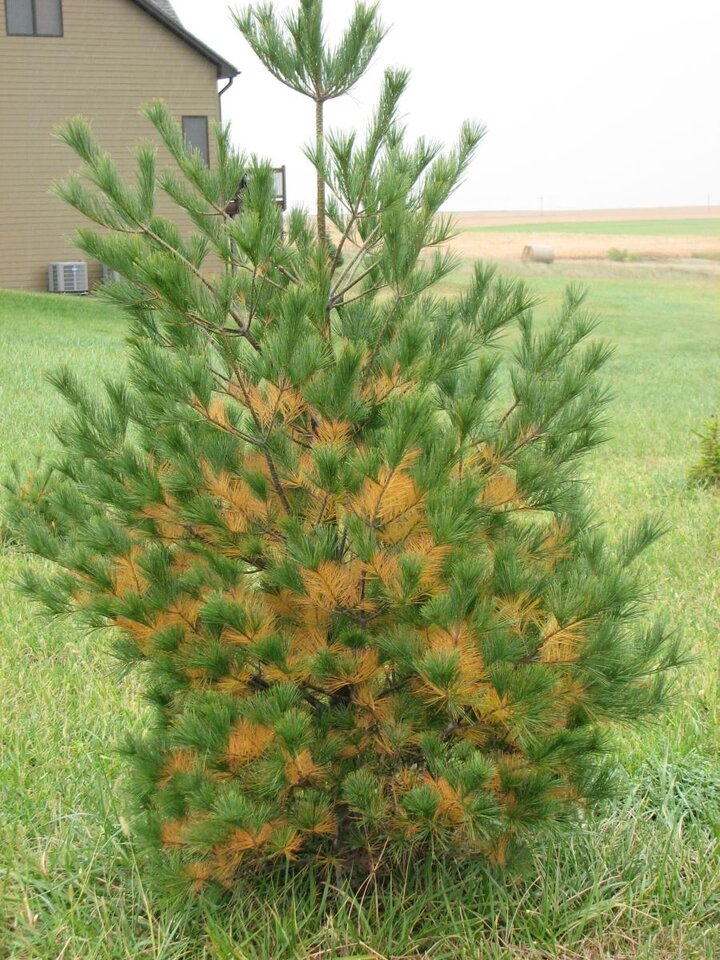Sarah Browning, Nebraska Extension Educator
Close-up of bright yellow colored eastern white pine needles during natural needle drop. Image by Sarah Browning, Nebraska Extension Educator.
Did you realize some evergreen needles change color in the fall too, just like deciduous trees do? It's true and it often causes alarm in homeowners when their evergreen trees start to drop needles.
Although most conifer trees are considered to be "evergreen", their needles don't live forever. What makes them evergreen is that their leaves persist more than one year before falling. Since new needles are added every year, there is always an overlap between green needles and those that are due to fall. When trees are healthy, vigorous and putting on a good amount of new growth each year, needles being shed in fall are hidden in the interior of the tree and harder to see. However, if a tree has been under stress and only putting on small amounts of new growth each year, needles shed naturally in fall are easier to see.
Natural needle drop is beginning now on our conifers in eastern Nebraska, so watch for this interesting process in your landscape evergreens.

Which Needles are Shed?
Older needles on the inside of evergreen trees are shed each fall after they turn yellow, brown or reddish tan in color. Usually this natural process is very subtle and goes unnoticed because only the inner-most needles are affected.
Pine trees can hold their needles for 2-5 or more years, depending on the species. Spruce trees generally hold onto their needles longer than pine trees do, approximately 5-7 years.
Here are some of the pines commonly grown in Nebraska and the number of years they hold their leaves:
- 2 years – eastern white, Jack (2-4 years) and Scotch (2-4 years) pine
- 3 years – Korean, Japanese black (3-5 years), Japanese red, Japanese white, lacebark, Macedonian and ponderosa pine
- 4 years – Austrian, red and Swiss stone pine
- 5 years – Bosnian and mugo pine

Eastern White Pine
Natural needle drop is particularly noticeable on eastern white pine. This tree only holds its needles for two years, which leaves less growth at the tip of branches to hide the needles as they are shed. Combined with the soft texture and open structure of this pine, yellowing needles are very noticeable.
Stress Can Increase Natural Needle Drop
Fall needle drop is a natural condition and is not a sign of disease or insect infestation, however, any factor that increases stress on evergreen trees will intensify the autumn needle drop. Stress factors include drought, herbicide injury, root damage and insect or disease damage.
How can tell the difference between natural needle drop and a insect or disease problem?
- Natural needle drop occurs only on the inner needles; if entire branches or needles at the tips of branches are turning yellow or brown, then something else is happening.
- Spider mites - needles will not be the clear yellow color seen in natural needle drop. Instead, they will be stippled with many tiny yellow pinpricks where mites have been feeding.
- Fungal needle diseases - In spruces, black fungal structures will be seen growing from the needle's stipule openings, which are normally white. In pines, brown lesions are seen on the needles.
- Purpling of spruce needles - often related to drought damage or root problems.
If you need help determining the cause of evergreen needle yellowing, Nebraska Extension can help.
- Contact your local Nebraska Extension office or
- submit pictures of your tree to our Digital Diagnostic Network for diagnosis.

Ever Heard of a Deciduous Conifer?
Believe it or not, there are actually a few types of conifers that shed ALL their needles EVERY year. These deciduous conifers include larch, bald cypress and dawn redwood. Larch needles turn a golden yellow, while bald cypress and dawn redwood needles develop a bronze hue. All three can add great beauty to the fall landscape.
Unfortunately, these trees are unusual enough in Nebraska landscapes that occasionally a homeowner will remove a tree they mistakenly think has died in fall. Yikes!
Images by Sarah Browning, Nebraska Extennsion Educator.
- Early signs of natural needle drop on Austrian pine, Pinus nigra.
- Eastern white pine tree exhibiting natural needle drop.
- Bald cypress is a deciduous conifer and loses all its needles in fall. This tree is showing the first interior browning needles indicating that it will drop its needles in a few weeks.
Search Our Archive
Associated Video
Spruce Diseases
UNL Extension Assistant Plant Pathologist Kevin Korus shows us three different spruce diseases and talks about how to avoid them